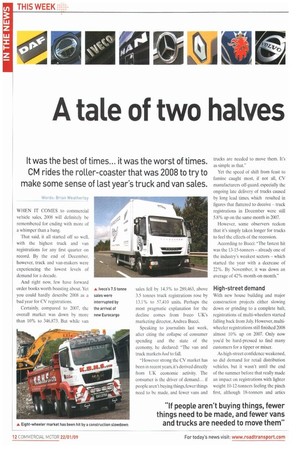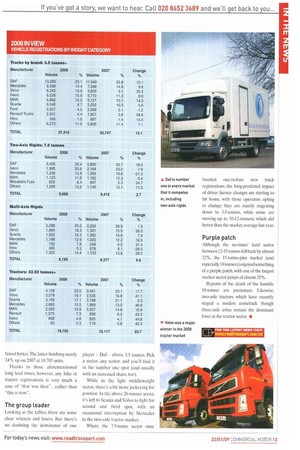A taLe of two halves
Page 12

Page 13

If you've noticed an error in this article please click here to report it so we can fix it.
It was the best of times... it was the worst of times. CM rides the roller-coaster that was 2008 to try to make some sense of last year's truck and van sales.
Words: Brian Weatherley WHEN IT COMES to commercial vehicle sales, 2008 will definitely be remembered for ending with more of a whimper than a bang.
That said, it all started off so well, with the highest truck and van registrations for any first quarter on record. By the end of December, however, truck and van-makers were experiencing the lowest levels of demand for a decade.
And right now, few have forward order books worth boasting about. Yet you could hardly describe 2008 as a bad year for CV registrations.
Certainly, compared to 2007, the overall market was down by more than 10% to 346,873. But while van sales fell by 14.3% to 289,463, above 3.5 tonnes truck registrations rose by 13.1% to 57,410 units. Perhaps the most pragmatic explanation for the decline comes from Iveco UK's marketing director, Andrea Bucci.
Speaking to journalists last week, after citing the collapse of consumer spending and the state of the economy, he declared: "The van and truck markets had to fall.
-However strong the CV market has been in recent years, it's derived directly from UK economic activity. The consumer is the driver of demand... if people aren't buying things, fewer things need to be made, and fewer vans and trucks are needed to move them. It's as simple as that."
Yet the speed of shift from feast to famine caught most, if not all, CV manufacturers off-guard, especially the ongoing late delivery of trucks caused by long lead times, which resulted in figures that flattered to deceive truck registrations in December were still 5.8% up on the same month in 2007.
However, some observers reckon that it's simply taken longer for trucks to feel the effects of the recession.
According to Bucci: -The fastest hit was the 13-15-tonners already one of the industry's weakest sectors which started the year with a decrease of 22%. By November, it was down an average of 42% month-on-month."
High-street demand
With new house building and major construction projects either slowing down or grinding to a complete halt, registrations of multi-wheelers started falling back from July. However, multiwheeler registrations still finished 2008 almost 10% up on 2007. Only now you'd be hard-pressed to find many customers for a tipper or mixer.
As high-street confidence weakened, so did demand for retail distribution vehicles, but it wasn't until the end of the summer before that really made an impact on registrations with lighter weight 10-12-tonners feeling the pinch first, although 18-tonners and artics faired better. The latter finishing nearly 24% up on 2007 at 18,705 units.
Thanks to those aforementioned long lead times, however, any hike in tractor registrations is very much a case of "that was then".. .rather than "this is now".
The group Leader
Looking at the tables, there are some clear winners and losers. But there's no doubting the dominance of one player Daf above 3.5 tonnes. Pick a sector, any sector, and you'll find it in the number one spot (and usually with an increased share, too).
While in the light middleweight sector, there's a bit more jockeying for position. In the above 26-tonnes arena, it's left to Scania and Volvo to fight for second and third spot, with an occasional interruption by Mercedes in the two-axle tractor market.
Where the 7.5-tonne sector once boasted one-in-four new truck registrations, the long-predicted impact of driver licence changes are starting to hit home, with those operators opting to change; they are mainly migrating down to 3.5-tonnes, while some are moving up to 10-12-tonners, which did better than the market average last year.
Purple patch
Although the no-mans' land sector between 12-15 tonnes fell back by almost 22%, the 15-tonne-plus market (and especially 18 ton ners) enjoyed something of a purple patch, with one of the largest market sector jumps of almost 25%.
Reports of the death of the humble 18-tonner are premature. Likewise, two-axle tractors, which have recently staged a modest comeback though three-axle artics remain the dominant force in the tractor sector. • mit .tam/an
















































































































































